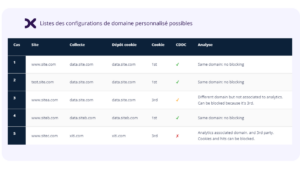Piano Analytics and the End of Third-Party Cookies

With over 20 years of experience, Vanessa CRITON, Manager of Analytics & Conversion, supports companies in their data projects. Her expertise in analytics and web marketing enables her to provide concrete solutions to her clients’ business challenges. Her rich and diverse professional background has led her to work in various sectors and to master a multitude of tools for which she is a certified expert.
Key Takeaways :
- The end of third-party cookies on Google Chrome is scheduled for early 2025.
The impact of the end of third-party cookies on analytics data collection will be minimal in most cases, or even nonexistent for users of Piano Analytics.
The digital marketing industry is experiencing one of the biggest changes since its inception: the end of third-party cookies. While some browsers, such as Apple’s Safari and Mozilla Firefox, have already taken measures against third-party cookies, the market is primarily concerned, as evidenced by its delays, by Google’s announcements regarding its Chrome browser.
The market leader now plans to end third-party cookies on its Google Chrome browser around early 2025. The fateful date has been pushed back, but questions still arise regarding the impacts this change may generate within the framework of analytics. Let’s examine what this means for Piano Analytics.
This article explores the impact of the end of third-party cookies and how Piano Analytics offers an alternative approach for data collection and analysis.
Less Data Collected?
The first thought that may come to mind when considering the end of third-party cookies is to associate this end with a decrease in the volume of data collected. This concern is understandable, given how much the industry has relied on these third-party cookies for years.
Since 2018, the AT Internet solution (now Piano Analytics) has opted for the use of first-party cookies to avoid restrictions imposed by certain browsers (e.g., Safari’s ITP) on third-party cookies. Therefore, the cookies set by the solution are not affected by the disappearance of this type of cookie.
However, this does not prevent ad blockers from significantly reducing data collection. To temporarily circumvent these ad blockers, Piano allows the use of a custom data collection domain called “Custom Domain Data Collection” (CDDC). Based on a declared collection subdomain on your Domain Name Server (DNS), this collection system enables you to recover additional traffic volume—at least until the ad blockers are updated to detect the workaround.
Here is an example of subdomain configuration allowing first-party tracking:
(source: Piano Analytics)

Thanks to the technical capabilities of Piano Analytics, the end of third-party cookies does not mean the end of analytics data.
Complexity in tracking conversions for your campaigns?
Now that you know that your on-site data collection with Piano Analytics is first-party and reliable, let’s take a closer look at media tracking and conversions.
First and foremost, it is essential to properly track your media campaigns (SEA, Social, CRM, etc.) so that the data can be easily found in Piano and you can distinguish between the different sources of visitor acquisition. This is a prerequisite that is still often overlooked. The more gaps or errors there are in tracking the campaigns, the greater the biases in interpretation will be.
Regarding media tracking, the end of third-party cookies will impact one element that will then be more difficult to track: the tracking of ad impressions. If you track the display of your ads on third-party publisher sites, the cookie that will be placed will necessarily be a third-party cookie.
For example, on the site “converteo.com,” where Piano will collect data via the Custom Domain Data Collection (CDDC) “track.converteo.com” in first-party. However, if the collection of ad impressions occurs on a publisher site such as lemonde.fr, we will then be in a third-party context because the domains are different. Impressions will still be collected but individually and without necessarily being linked to a known user, as these cookies may have already expired. In summary, it will be possible to have impression volumes, but taking them into account will lead to biased attribution.
Aside from these ad impressions, the segments in Piano Analytics will still be usable. Your visitors will be tracked from one session to another thanks to the first-party cookies from Piano.
_
Piano has been able to anticipate the technical evolutions of the market to offer a data collection solution that meets the current needs of businesses. Piano Analytics is not directly affected by the disappearance of third-party cookies, unlike the media tags on your traffic acquisition channels.
To date, the most common solution to address the disappearance of third-party cookies is the implementation of server-side data collection, also known as Server Side.
This collection method can also be applied to Piano Analytics. It allows, among other things, for an end to ad blockers, better cookie quality, and a much larger volume of data.
Would you like to learn more about Server Side and Piano Analytics?

